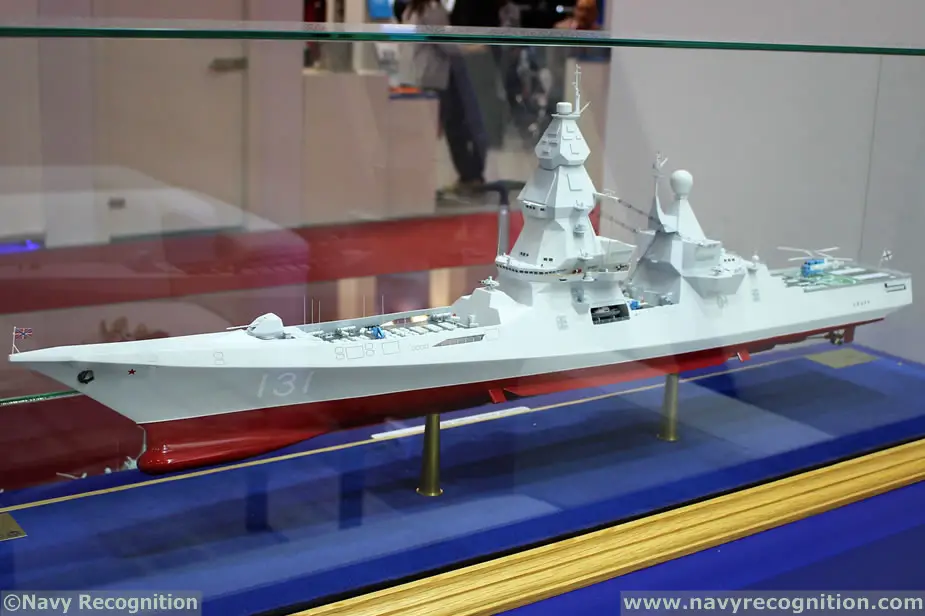Open sources reported in July 2018 that it had been decided to take a break in the creation of a prospective destroyer (heavy nuclear missile cruiser) of project 23560. A publication in February 2020 in FlotProm online media outlet did not add anything new. However, the headline Leader Destroyer Listed as Outsider and some statements (project stopped because of lack of funds, prospective nuclear cruiser is not even discussed, it is a distant future) caused concern of specialists. Expert Alexander Shishkin writes about project 23560 prospects in his blog.
 Scale model showing the Project 23560E "Shkval-class" Destroyer (export variant of Leader-class) at Army 2018 exhibition (Picture source: Navy Recognition)
Scale model showing the Project 23560E "Shkval-class" Destroyer (export variant of Leader-class) at Army 2018 exhibition (Picture source: Navy Recognition)
The pause in project 23560 was caused by project 22350M. It appeared as the Navy command comprehended that it was impossible to rapidly renew the green-water force of big (displacement of 14-19 thousand tons) and sophisticated nuclear-powered warships. The new frigates (or destroyers) with a displacement of 8000 tons armed with 112-cell universal vertical launchers (Arleigh Burke of IIA series has 96) should become the main green-water warships. They can be built in the old slipway of Severnaya Verf or Yantar Shipyards. However, they are insufficient for proper operations in the World Ocean.
At present, Russian Navy sustainability in distant areas is ensured by missile cruisers of projects 11442 and 1164 (big antisubmarine ships of project 1155 and frigates of projects 11540 and 11356 only demonstrate Navy presence and flag). Russia remains a world leader in multirole non-aircraft carrier surface warships of a big displacement. No other country has warships exceeding in firepower the Petr Veliky, the Admiral Nakhimov, the Moskva, the Varyag and the Marshal Ustinov warships. However, the cruisers are not young while new challenges are on the horizon.
On January 12, 2020, the Nanchang destroyer (or missile cruiser) with hull number 101 became operational in the Chinese Navy. It is the lead Type 055 warship with a full displacement estimated at 10000 tons. Two more warships are being built, three have been floated and two undergo running trials. Thus, as the Nanchang construction takes five years, the Chinese Navy will have several warships of the type by late 2023. Besides China, the United States, Japan and South Korea have warships with a displacement of 10000 tons (from 9300 to 10450) which exceed the projected Russian 22350M in size.
Xinhua news agency estimated Type 055 displacement at 10 thousand tons. Jane’s 360 believes it can reach 12-13 thousand tons. Google Earth satellite images showed the warship is 176 meters long (not 180 as claimed) and 20 meters wide. The waterline calculated by the Nanchang photos is 163 meters long and 18.5 meters wide. The length and width of the waterline, the 6-meter draft and displacement of 10000 tons (11300 tons full displacement) theoretically do not differ from missile cruiser of project 1164.
The United States, which abandoned the program to build 19 CG(X) cruisers and cut the series of Zumwalt-class destroyers from 32 to three ships, was impressed by the Chinese shipbuilding program and considered the creation of a heavy cruiser of a new generation. If everything goes according to the plan, the design of the series is likely to begin in 2021 and will take close to five years. The Navy will receive the first warship in the early 2030s. The Americans learned the sour experience of DDG-1000 and will hardly engage in major innovations. They are likely to use traditional architecture and create a multirole warship exceeding the Chinese analogue by displacement and the number of launcher cells (the Nanchang has 112 and the Ticonderoga - 112).
The Russian naval doctrine up to 2030 calls to prevent considerable supremacy of other navies and keep the second place in combat capabilities. It is clear Russia will not stay away from competition of the leading powers in naval arms.
© Copyright 2020 TASS. All rights reserved. This material may not be published, broadcast, rewritten or redistributed.



